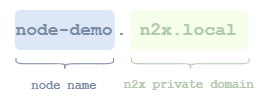DNS in n2x.io
Internal DNS Service
n2x.io provides each node on your network with a unique IP address that stays the same no matter where your devices are. However, managing nodes on your network often involves remembering complex IP addresses. This can be cumbersome and error-prone. n2x.io offers a solution with its built-in internal DNS (Domain Name System) service.
The internal DNS automatically assigns a unique FQDN (Fully Qualified Domain Name) to every node on your network. This eliminates the need to memorize IP addresses, streamlining nodes management and making it more user-friendly.
The FQDN for the nodes comprises two parts:

In the case of Kubernetes integration, the fully qualified domain name for workloads or services comprises three parts:

Querying the Internal DNS Service
By default, you can query this internal DNS service on UDP port 53535 of any n2x-node. Here's a command using the dig tool to illustrate this process:
dig @<NODE-IP> -p 53535 A <FQDN>
Info
Replace <NODE-IP> with the IP address of a n2x-node and <FQDN> with the specific FQDN you want to resolve.
Example
dig @10.254.0.213 -p 53535 A node-demo.n2x.local
; <<>> DiG 9.18.18-0ubuntu0.22.04.2-Ubuntu <<>> @10.254.0.213 -p 53535 A node-demo.n2x.local
; (1 server found)
;; global options: +cmd
;; Got answer:
;; WARNING: .local is reserved for Multicast DNS
;; You are currently testing what happens when an mDNS query is leaked to DNS
;; ->>HEADER<<- opcode: QUERY, status: NOERROR, id: 49538
;; flags: qr aa rd; QUERY: 1, ANSWER: 1, AUTHORITY: 0, ADDITIONAL: 0
;; WARNING: recursion requested but not available
;; QUESTION SECTION:
;node-demo.n2x.local. IN A
;; ANSWER SECTION:
node-demo.n2x.local. 300 IN A 10.254.0.175
;; Query time: 15 msec
;; SERVER: 10.254.0.213#53535(10.254.0.213) (UDP)
;; WHEN: Tue Apr 16 11:12:49 CEST 2024
;; MSG SIZE rcvd: 76
DNS Integration
The .n2x.local domain can be seamlessly integrated into your existing DNS infrastructure for further flexibility. Refer to the DNS Integration guide for more details.